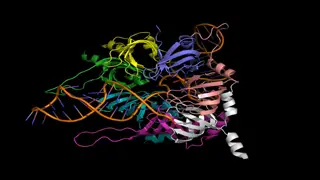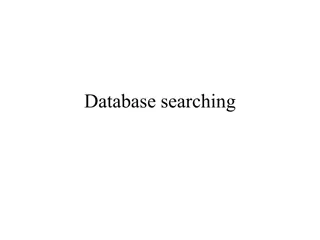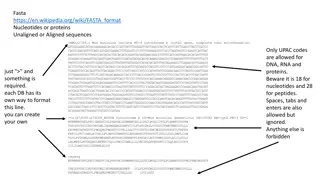
Understanding Sensitivity and Selectivity in Database Searching
Explore the concepts of sensitivity and selectivity in database searching through examples and scenarios. Learn how to calculate these metrics for efficient data analysis and decision-making in various fields such as healthcare and bioinformatics.
Download Presentation

Please find below an Image/Link to download the presentation.
The content on the website is provided AS IS for your information and personal use only. It may not be sold, licensed, or shared on other websites without obtaining consent from the author. If you encounter any issues during the download, it is possible that the publisher has removed the file from their server.
You are allowed to download the files provided on this website for personal or commercial use, subject to the condition that they are used lawfully. All files are the property of their respective owners.
The content on the website is provided AS IS for your information and personal use only. It may not be sold, licensed, or shared on other websites without obtaining consent from the author.
E N D
Presentation Transcript
Database Searching (FASTA) Lecture 8 Department of CSE, DIU
CONTENTS 1. TP, TN, FP, FN 2. Selectivity, Sensitivity 3. Hash Table used in FASTA
1. TP, TN, FP, FN True Positive, True Negative, False Positive, False Negative
A patient fears that he has Cancer & Goes to the doctor for Diagnosis
Possible Scenarios True Positive True Negative Patient really had cancer & Diagnosis came Positive Patient didn t have cancer & Diagnosis came Negative False Positive False Negative Patient didn t have cancer & Diagnosis came Positive Patient really had cancer & Diagnosis came negative
2. Selectivity and Sensitivity We will learn about calculating selectivity and sensitivity
Selectivity & Sensitivity ???? ???????? ??? ???????? ???? ???????? ??? ???????? Sensitivity = Selectivity =
???? ???????? ??? ???????? Sensitivity = Worked Out Example (Sensitivity) Suppose we are searching the character C in entire database Dataset A G Each time we encounter a C we should print C C T So the final output of search should be = CCC as there are 3 Cs in the entire dataset. But the outcome is ACC G T G C A G So, All Positive = 3(as there are 3 Cs in the whole dataset and we are looking for C only) C G True Positive =number of Cs in the outcome ACC = 2 Search Character = C Expected = CCC Outcome = ACC Sensitivity = 2 3
???? ???????? ??? ???????? Selectivity = Worked Out Example (Selectivity) Suppose we are searching the character C in entire database Dataset A G Each time we encounter a C, we should print C C T So the final output of search should be = CCC as there are 3 Cs in the entire dataset. But the outcome is ACC G T G C A G So, All Negative = 9(Number of entries in the dataset that is not C ) C G True Negative =number of entries in the outcome ACC that is not C = 1 Search Character = C Expected = CCC Outcome = ACC Sensitivity = 1 9
3. Hash Table Used in FASTA Hash Table Algorithm
Given Data Query Sequence: JUSTICELEAGUE Target Sequence: LEAGUEOFASSASINS Value of K : 1
Step 1 : Build Query Table 1 2 3 4 5 6 7 8 9 10 11 12 13 J U S T I C E L E A G U E
Step 2: Hash Table for Query Sequence Write all the distinct characters appeared in the Query Sequence Lexicographically and then, beneath that, write the number of the position in which that letter appeared. There can be multiple occurrences. A C E G I J L S T U 10 6 7 9 11 5 1 8 3 4 2 12 13
Step 3 : Build Target Table 1 2 3 4 5 6 7 8 9 10 11 12 13 14 15 16 L E A G U E O F A S S A S I N S
Step 4 : Import the Hash Table for Query Sequence A C E G I J L S T U 10 6 7 9 11 5 1 8 3 4 2 12 13 1 2 3 4 5 6 7 8 9 10 11 12 13 14 15 16 L E A G U E O F A S S A S I N S
Step 5 : Build the Exteded Target Table based on Hash Table A C E G I J L S T U 10 6 7 9 11 5 1 8 3 4 2 12 13 1 2 3 4 5 6 7 8 9 10 11 12 13 14 15 16 L E A G U E O F A S S A S I N S 7 5 7 11 7 7 -3 7 1 3 7 1 -7 -8 -2 -10 -9 -13 Entry in Extended Row = Position of the Letter in Hash Table Position of the Letter in Extended Target Table Example: For L, in Extended Target Table, Entry is 7 (8-1) . Similarly For E, the entries are 5 (7-2), 7 (9-2) and 11 (13-2).
Step 5 : Build Offset Table Draw a table from the minimum to the maximum entry of the extended target table. Then beneath each entry number, write down number of times that entry occurred in extended target table. For example, the entry 7 Occurred 6 times and the entry 1 occurred 2 times. -13 -12 -11 -10 -9 -8 -7 -6 -5 -4 -3 -2 -1 0 1 2 3 4 5 6 7 8 9 10 11 1 1 1 1 1 1 1 2 1 6 1 1
Step 6: Build Pre-Final Table Start both Query and Target sequence from 0 position. 0 1 2 3 4 5 6 7 8 9 10 11 12 13 14 15 J U S T I C E L E A G U E L E A G U E O F A S S A S I N S
Step 7 : Build Final Table Find out the entry number from the offset table, that occurred maximum number of times (Here 7, which occurred 6 times). After that, add that entry number with the previous starting position of target sequence to get the new starting Position of Target Sequence (Previous starting position = 0, Then new startingposition of target seqbecomes 0 + 7 = 7). 0 1 2 3 4 5 6 7 8 9 10 11 12 13 14 15 16 17 18 19 20 21 22 J U S T I C E L E A G U E L E A G U E O F A S S A S I N S



















